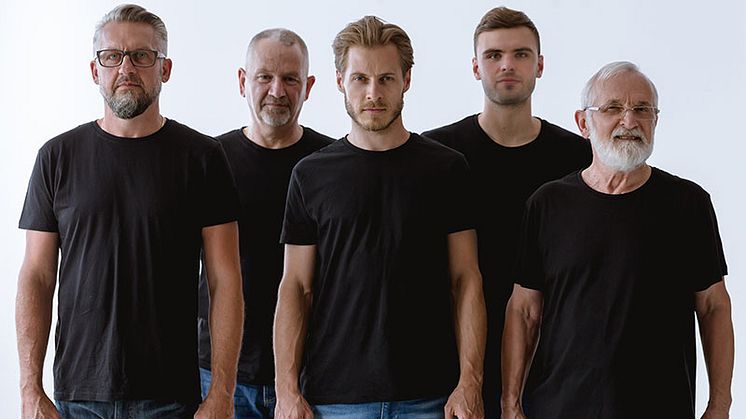
Blog post -
How Gynecomastia Look Like In Men Of Different Ages
A common misconception about gynecomastia, or "man boobs," is that the condition is caused solely by excess fat. In truth, breast tissue alone is the primary cause of gynecomastia. Excess fat is a secondary component, followed by skin laxity.
Many patients assume that liposuction alone will fix the issue – they may have been ill-advised by inexperienced doctors – as liposuction on its own rarely produces the results patients seek to get rid of the medical condition effectively.
Dr Ivan Puah details the various presentations of gynecomastia, including its basic anatomy and various gynecomastia grades and how gynecomastia looks like in men of different ages.
The Anatomy Of Gynecomastia


Gynecomastia is very common in men, and it is estimated that approximately 60% to 70% of the male population has this medical condition. Anatomically, the male breast is similar to the female breast, extending from the second to the sixth anterior rib. The sternum is the medial border, and the mid-axillary line is the lateral border.
Ideally, the male chest is flat with prominent pectorals. In a patient with gynecomastia, the male breast will have a more pyramidal shape with feminine features. Excess glandular tissue and fat surrounding the breast are the primary classifications of gynecomastia.
Several reasons cause this tissue to develop, including hormonal imbalance, genetics, and side effects of medications.

Grades of gynecomastia

Gynecomastia Grade I
.jpg)
Gynecomastia Grade II

Gynecomastia Grade III
.jpg)
Gynecomastia Grade IV
.jpg)
How Does Gynecomastia Look Like In Men Of Different Ages

Gynecomastia may happen at different phases of their lives. Causes may vary, and the treatment to be recommended is also dependent on their age.
Gynecomastia can look different in men of different ages, and its appearance can vary based on various factors such as the severity, cause, and duration of the condition.
Here's how gynecomastia may look like in men of different ages:
Neonatal gynecomastia
This occurs in newborn babies and is usually due to the presence of maternal hormones in the baby's body. In most cases, the breast enlargement resolves on its own within a few weeks or months after birth.
Pubertal gynecomastia
This type of gynecomastia is common in boys during puberty due to hormonal changes. The breast tissue may appear slightly enlarged and tender, and the areola may become more prominent. In most cases, pubertal gynecomastia resolves on its own within a few months or one to two years.
Adult gynecomastia
Gynecomastia in adult men can vary in appearance based on its severity and duration. In mild cases, the breast tissue may appear slightly enlarged, while in more severe cases, the breast tissue can become noticeably enlarged, saggy, and droopy. Gynecomastia can occur unilaterally (one breast) or bilaterally (both breasts).
Senescent gynecomastia
This type of gynecomastia occurs in older men and is often due to age-related hormonal changes. The breast tissue may appear enlarged, saggy, and droopy, and the areola may become larger.
Gynecomastia in the Adolescent/Teenage Years
According to the National Institutes of Health (NIH), 50% to 60% of adolescent males suffer from gynecomastia. In boys, temporary gynecomastia may occur during puberty due to changes in hormone levels. The decrease in testosterone compared to estrogen is the leading cause.
As early as 10, some boys may start experiencing the symptoms of gynecomastia, peaking between the ages of 13 and 14. At age 17, around 10% will continue to experience gynecomastia. In most cases, the issue goes away on its own by the time they reach 21 years of age.
Hormonal changes
Adolescent gynecomastia is caused by an imbalance of hormones, specifically an increase in estrogen (female hormone) and a decrease in testosterone (male hormone).
Breast Enlargement
The breast tissue in adolescent boys with gynecomastia appear enlarged and tender to the touch. The areola may also become more prominent. It can occur on one breast (unilateral) or both breasts (bilateral).
Psychological Impact
Adolescent gynecomastia can have a negative impact on self-esteem and body image, which can affect his mental health.
Treatment options
In cases where the gynecomastia persists or causes significant psychological distress, gynecomastia surgery is recommended.
Gynecomastia in the 20s

Gynecomastia that has remained undiagnosed and untreated is likely the reason behind men who experience the condition well into their 20s. Other causes of gynecomastia besides undiagnosed from teens gynecomastia include:
Underlying health conditions
Gynecomastia can be a symptom of an underlying health condition, such as a hormonal disorder or certain types of cancer.
Medications and drugs
Certain medications and drugs, such as anabolic steroids or anti-androgen drugs, can cause gynecomastia.
Men in this category generally have Grade I and II gynecomastia. Those who are overweight or obese, most often than not, have Grades III and IV. Puffy nipples are common and more pronounced. As the breast tissue grows, it will hang over the crease of the breast, creating a rounded appearance - the opposite of the typical sculpted, masculine look.
Young men affected by the condition may find themselves challenged physically and mentally. They may not wear tight-fitting clothes and resent looking at themselves in the mirror. The "man boobs" appearance may also be more prominent if there have been significant fluctuations in weight over the years.
Gynecomastia in the 30s

Signs of laxity may already start to appear for men in their 30’s. Fluctuations in weight can worsen the situation, resulting in a more severe form of gynecomastia. This can negatively affect the individual as they become more self-conscious and reclusive. This may impede their social and professional opportunities, resulting in declining mental well-being.
Causes of gynecomastia at this age may also be due to medications, drugs or anabolic steroid abuse. Hormonal imbalance could still be an underlying factor as well.
Hormonal changes
Like other age groups, hormonal changes can cause gynecomastia in men in their 30s. This can include an increase in estrogen levels, a decrease in testosterone levels, or both.
Breast enlargement
Men with gynecomastia in their 30s may notice enlarged breast tissue, which can feel tender or sore to the touch. The breast tissue may be firm or rubbery. Signs of loose skin start to appear due to fluctuations in weight over the years.
Medications and drugs
Certain medications and drugs, such as those used to treat depression or high blood pressure, can cause gynecomastia. Substance abuse, including alcohol and marijuana, can also be a factor.
Health conditions
Gynecomastia can be a symptom of underlying health conditions such as liver disease, thyroid disorders, or tumours.
Psychological impact
Gynecomastia can have a negative impact on a man's self-esteem and body image, which can affect his mental health.
Gynecomastia in the 40s

In their 40s, men will experience fluctuating weight and hormones, affecting their bodies. The skin will start to stretch and be lax, among other things.
Gynecomastia is a common breast lesion. Hence, a proper diagnosis must be made to accurately determine the issue. Certain medications may also be a cause. These include:
- Steroids
- Antidepressants
- Cardiac, epilepsy and anti-ulcer medicines
During a consultation, it is therefore highly advisable for a patient to inform the doctor of the medication that they are taking.
Breast enlargement
Men with gynecomastia in their 40s may notice enlarged breast tissue, which can feel tender or sore to the touch. The breast tissue may be firm or rubbery.
Other causes besides hormones
Certain medications and drugs, such as those used to treat prostate cancer or heart conditions, can cause gynecomastia.
Health condition
Gynecomastia can be a symptom of underlying health conditions such as liver disease, thyroid disorders, or tumours.
Lifestyle factors
Obesity and excessive alcohol consumption can also increase the risk of gynecomastia in men in their 40s.
Psychological impact
Gynecomastia can hurt a man's self-esteem and body image, which can affect his mental health.
Gynecomastia in the 50s & During Andropausal

Andropause can begin in the 40s for men, but it is more common in their 50s that it is more prevalent. Andropause is when male hormone production, especially testosterone, declines. Side effects include hair loss, insomnia and gynecomastia.
The drop in testosterone levels leaves the body unable to balance out the estrogen that's being produced, and this can lead to the appearance of gynecomastia. Additionally, severe hyperthyroidism can also cause gynecomastia.
Gynecomastia surgery with 360°GTD: A Customised Approach For All Types Of Gynecomastia Conditions

Dr Ivan Puah, Medical Director at Amaris B. Clinic has more than 17 years of surgical body sculpting procedures including gynecomastia surgery and corrective liposuction.
Each gynecomastia case is unique. The surgical approach must be versatile to address the issue effectively.
The 360°GTD® approach to gynecomastia is unique because it factors in a patient's condition and needs and delivers results accordingly. Developed by Dr Ivan Puah, Medical Director of Amaris B. Clinic, this approach has enabled him to help men of all ages address their gynecomastia issues.
Only small incisions are required during gynecomastia surgery, which minimises scarring and reduces the risk of haematoma. Suction drainage is also unnecessary, eliminating the appearance of post-procedure scars and the risk of infection.
For men whose gynecomastia issue is compounded with excess chest fat, Dr Puah's MDC-Sculpt®️ Lipo Technique, a form of modern liposuction, is an effective option. This approach not only enables him to remove fat efficiently, but he is also able to sculpt the chest for a more defined appearance.
Gynecomastia, as evident, can occur in men and boys at any age. Accordingly, the approach to addressing the issue must be as unique as the individual situations and needs. Finding a doctor who truly understands this and is experienced and qualified is essential to seeking help.
Reference
[1] [2] Blau M, Hazani R, Hekmat D. Anatomy of the Gynecomastia Tissue and Its Clinical Significance. Plast Reconstr Surg Glob Open. 2016 Aug 30;4(8):e854. DOI: 10.1097/GOX.0000000000000844. PMID: 27622122; PMCID: PMC5010345.
[3] Simon B E, Hoffman S, Kahn S. Classification and surgical correction of gynecomastia. Plast Reconstr Surg. 1973;51(1):48–52.



